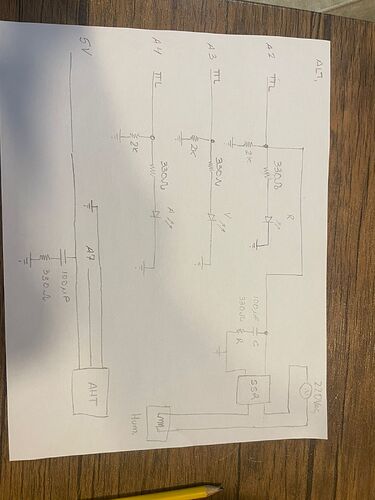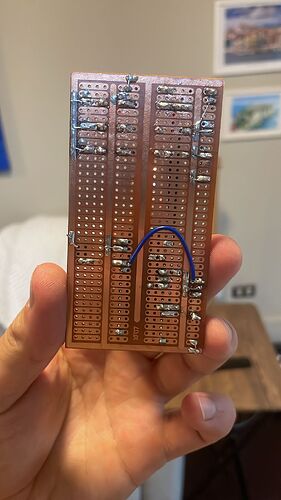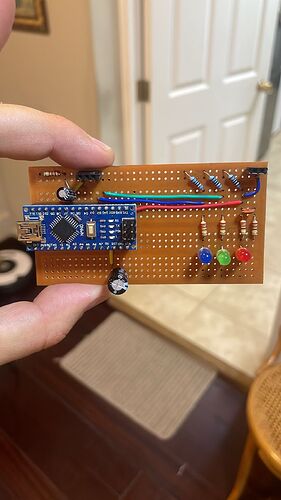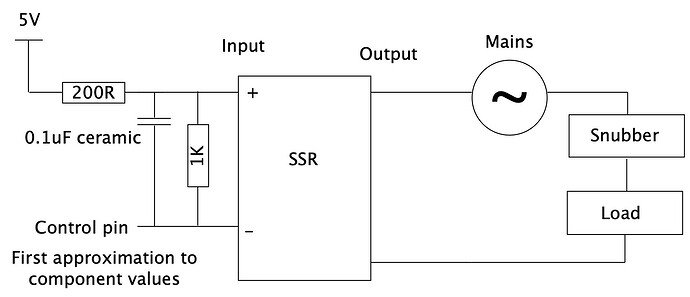I am working on a control circuit for a humidifer in a shiitake mushroom growing room. That equipment consists of an AC motor that spins a disk spraying mist over the room, rated at 300W working under 220Vac. The arduino opens or closes the circuit via a solid state relay SSR25DA, based on the humdity read by the DHT sensor.
I have designed the four following stages:
Stage 1: Humidity below 75%. SSR is on. Red led on.
Stage 2: Uptrend from 75% to 85%, SSR on. Red led on, green led flashing.
Stage 3: 85% or more reached. Only blue light on. Relay is off.
Stage 4: Downtrend from 85 to 75%. Only green led steady.
Error code: upon NaN read by sensor: flash green.
The circuit failed when using the humidifier as a load, with error code.
This circuit works fine with loads light a light bulb. I found that turning on the egg beater close to the circuit leads to the same error. This egg beater runs at 300W too. I added a snubber at the 5V terminals of the SSR. With this, i could run the egg beater to speed 4 (out of 5) with no failure. failing at 5. (when connected as load, at a distance of 5m of the arduino). This makes me think that maybe the mains cables themselves cause EMI on the arduino (distance = 0.5m from the SSR to the soldered breadboard. Not sure.
I have provided code and schematic. I am thinking of implementing a second circuit but wanted to ask for suggestions first.
#include <DHT.h> // Temp/hum
#include <Wire.h> // I2C
#define DHTPIN 7 // what pin we're connected to
#define DHTTYPE DHT22 // DHT 22 (AM2302)
DHT dht(DHTPIN, DHTTYPE);
float hum;
float marcador;
float temp;
void setup() {
// put your setup code here, to run once:
Serial.begin(9600); // Inicio comms Serial Monitor
Wire.begin();
dht.begin();
Serial.println("DHT iniciado");
pinMode(2, OUTPUT);
pinMode(3, OUTPUT);
pinMode(4, OUTPUT);
}
void flashinggreen() {
digitalWrite(3, LOW); //
delay(200);
digitalWrite(3, HIGH); //
delay(200);
digitalWrite(3, LOW); //
delay(200);
digitalWrite(3, HIGH); //
delay(200);
digitalWrite(3, LOW); //
}
void loop() {
// put your main code here, to run repeatedly:
String espacio = " ";
hum = dht.readHumidity();
temp = dht.readTemperature();
String nan = "NAN";
Serial.println(hum + espacio + temp);
String Hum = String(hum);
Serial.println(Hum);
if (isnan(hum)){
Serial.println("Error");
digitalWrite(2, HIGH); // apago luz roja
digitalWrite(4, HIGH); // apago azul
flashinggreen();
}
else{
if (hum <= 75) // Baja de humedad
{
digitalWrite(2, LOW); // prendo luz roja
digitalWrite(3, HIGH); // apago luz verde
digitalWrite(4, HIGH); // apago azul
Serial.println("Hum bajo 75, relay on");
delay(5000);
marcador = 1;
}
else{
if (hum<= 85){ // transicion
Serial.print("Verde transicion, marcador = ");
Serial.println(marcador);
if (marcador >= 1) {
digitalWrite(2, LOW); // mantengo luz roja
flashinggreen();
digitalWrite(4, HIGH); // apago azul
Serial.println("Hum normal, relay mantiene");
delay(1000);
}
else{
digitalWrite(2,HIGH); // apago roja
digitalWrite(3, LOW); // luz verde fija
digitalWrite(4, HIGH); // apago azul
Serial.println("relay off, en bajada");
delay(5000);
}
}
else{ // humedad mayor a 85
digitalWrite(2,HIGH);
Serial.println("Sobrehumedad, relay off");
digitalWrite(2, HIGH); // apago luz roja
digitalWrite(3,HIGH); // apago luz verde
digitalWrite(4, LOW); // prendo azul
marcador = 0;
delay(5000);
}
}
}
}
New circ
Original circ





